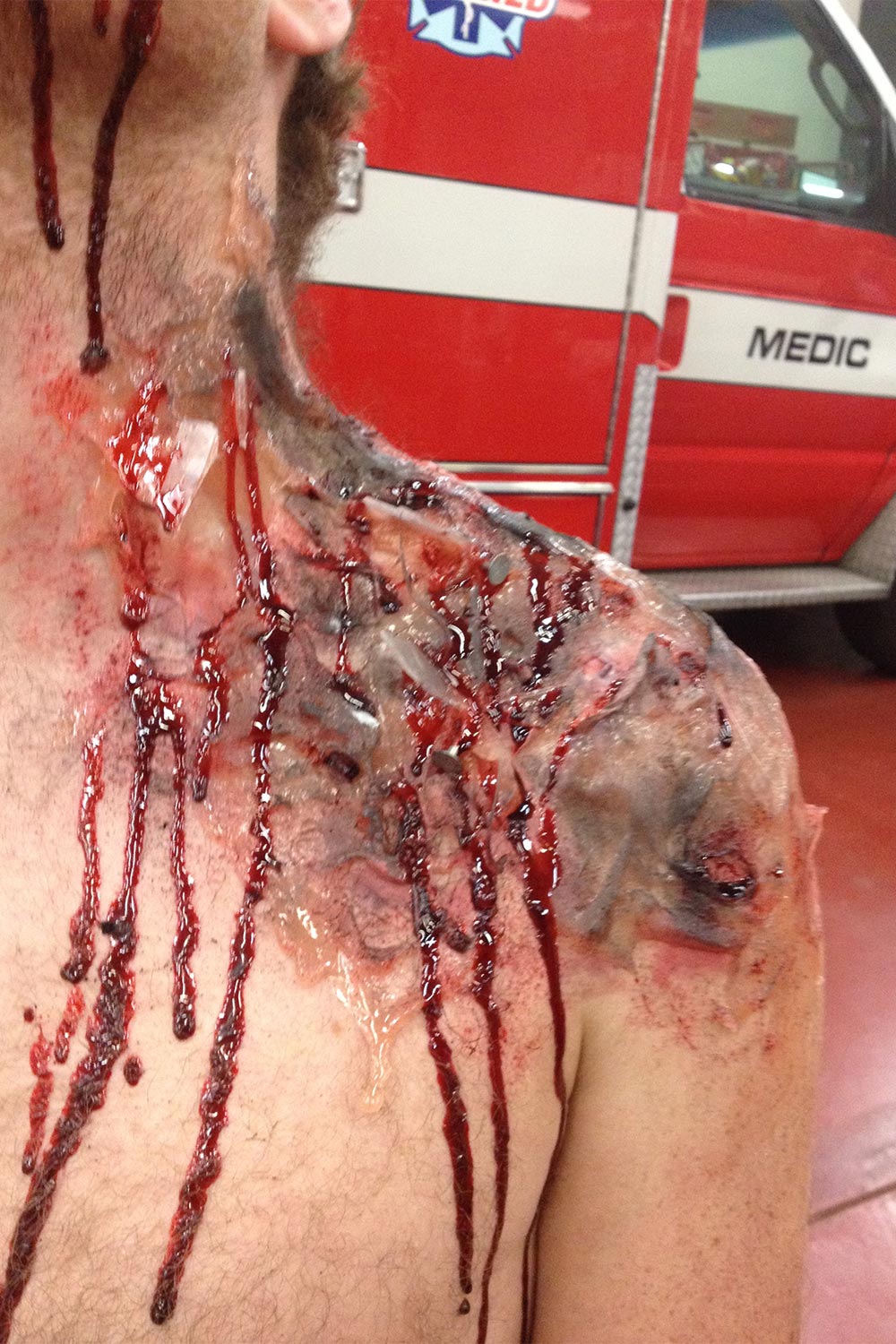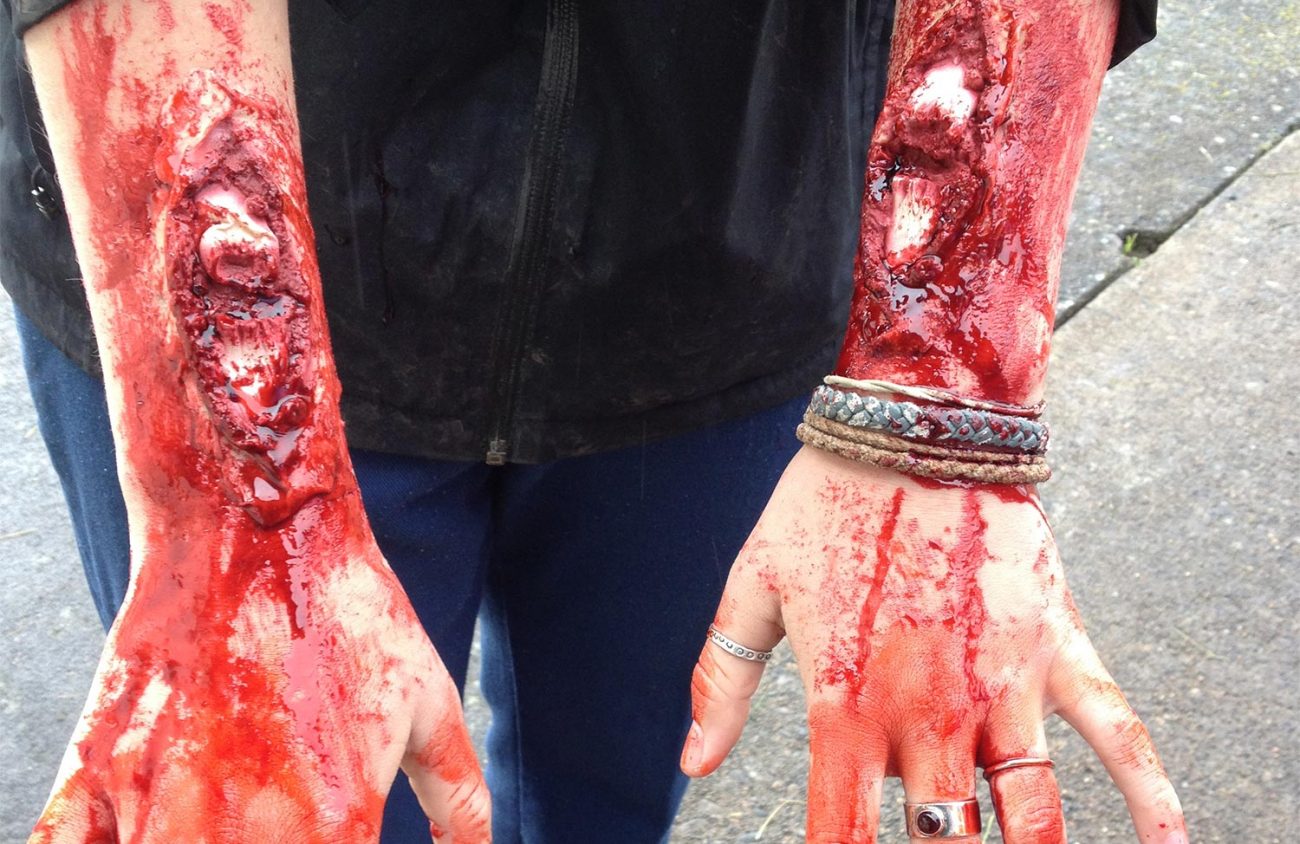Spurting arteries, lacerations and impaled objects — the special effects makeup that scares you to death in horror movies may save your life someday. Or it may help you save someone else’s life.
In the last several years, realistic mock wounds have become a mainstay of emergency response training at all levels. The art of applying those oozing gashes and crispy burns, called “moulage,” is booming in lockstep with a surge in preparedness activities in Oregon and across the country.
Together and separately, emergency professionals and citizen amateurs are practicing these rescue and triage skills. Increasingly lifelike drills mimic the mayhem and injuries from earthquakes, wildfires, floods, hurricanes, active shooters, terrorist bombs and other natural and human-caused disasters.
The people in greatest need after a disaster may be cut off from food, water, electricity and medical aid. For the first hours or days, survival may depend on trained citizens saving their neighbors.
“When moulage is part of the training, people are better able to handle it in real life,” says Roger Bailey, an emergency medical technician (EMT) in Eugene who uses moulage in wilderness first aid classes and applies his fake-blood splashing skills in other area training events. “We try and create realistic scenarios, which are often chaotic.”
“There’s a comfort zone, a learning zone and a panic zone,” says Lish Robinson, the lead simulations specialist at Oregon Health & Science University in Portland. Moulage helps bump a simulation into the learning zone. “[Education] research has shown a certain amount of anxiety helps things stick in your brain,” she says.
New research seems to validate the widely held gut feelings about the value of moulage. A small randomized study in Australia found that paramedical students responded faster when victims sported realistic wounds, but they were less technically adept, perhaps from being flustered.
In the test scenario of stab wounds and spurting blood, the response speed spelled the difference between life and death, the study’s lead author Brennen Mills writes in an email.
Different disaster scenarios dictate the specific injuries fashioned by moulage artists, says Eli Davis, emergency manager for PeaceHealth Oregon. Bombs call for blast and crush injuries. Active shooters call for bullet wounds, shrapnel and trampling.
One recent exercise at Lane Community College imagined a devastating Cascadia-style earthquake with collapsed buildings and survivors trapped in rubble. Many participants were trained citizens (called CERTs, for Community Emergency Response Team). Their mission: triage and rescue a grisly troupe of volunteer victims sculpted by Lisa Wimberley, a CERT trainer in Eugene. Wounds included a metal pipe piercing one woman’s thigh and poking through another one’s shoulder, rebar skewered below a side rib, bloody glass shards embedded in arms and hands, dripping head wounds and extensive bruising.
For a multi-agency countywide active shooter drill in May at Autzen Stadium, Aubrey Hamilton created more than 300 bullet wounds, entry and exit, to be applied to volunteer victims. “I started a month and a half out,” says Hamilton, who plowed through medical textbooks to get the details right. “It takes about 20 minutes for each prosthetic.” Hamilton graduated from Springfield High School last year. She once wanted to be a doctor, but is now saving money to go to Hollywood’s top makeup school.
Scenarios change every year, but they draw on detailed reports of actual incidents, Davis says. In the active shooter drill, the bullet wounds were modeled after the Columbine shooting injuries.
Moulage dates back centuries, starting in early Egypt as wax models representing deceased people and spreading throughout Europe. By the early 1700s, moulages were an established teaching method for medical students and doctors. A Swiss museum proudly displays part of its collection of 2,000 disease models, including 1,000 dermatological and venereal diseases and afflictions.
Modern moulage makers take the medical realism seriously. “We use forensic-based wounds that follow the science,” says Bobbie Merica, owner of Moulage Concepts in Paradise, California, who literally wrote the book on medical moulage.
Merica flies around the country training other moulage trainers. Her extensive repertoire includes military trauma, hemorrhagic rashes (think Ebola), mass chemical attacks and even veterinary moulage for dogs wounded in action. Moulage is crucial for delivering unequivocal training messages, she says. “Moulage is to a scenario what emojis are to text messages.”
Enlarge

Image courtesy Roger Bailey
For the handful of local practitioners, moulage is a side gig, born of experience in training others, such as Bailey and Wimberley, or from an interest in theater arts, such as Hamilton, whose talents were discovered during a drunk driving program at her school called “Every 15 Minutes.” The elaborate two-day educational program includes a staged crash of two cars.
“The kids are laughing and joking, but when you start the simulation, it’s dead quiet,” Hamilton says. “Even though I’m the one who put the makeup on them, when you bring in all the firefighters who take the students out of the vehicles it’s really intense. I’m getting shook up just thinking about it.”
Larger scenarios, such as the Autzen drill, may have a small budget for moulage. For the rest, moulage makers donate their time, help teach other and generously offer to train others on the fly.
“It’s a fun thing to do, anyway, even if it’s just for yourself for Halloween,” says Wimberley, whose day job is at a University of Oregon childhood education program. Her pro tip: Use professional supplies. The makeup from Halloween stores is terrible.
